|
 Aeruginospora furfuracea Aeruginospora furfuracea
BiostatusPresent in region - Indigenous. Endemic
Images (click to enlarge)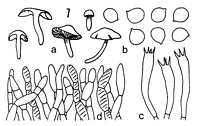
Caption: Aeruginospora furfuracea Hk. (type): a. carpophores. - b. spores. -c. basidia.-d. cuticle | 
Caption: Fig. 17 Aeruginospora furfuracea Horak (PDD 27075, type): A.
basidiomes. (B-E: ZT 1935): B. basidiomes C. spores. D. basidia. E. caulocystidia
(PDD 27189): F. basidiomes.
| 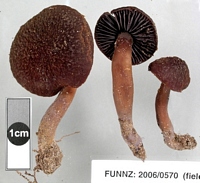
Caption: FUNNZ: 2006/0570, See public note for more information
Owner: FUNNZ | 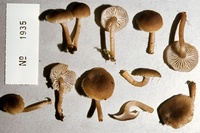
Caption: ZT1935
Owner: E. Horak: © Creative Commons Attribution-Noncommercial 3.0 New Zealand | 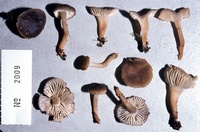
Caption: ZT2009
Owner: E. Horak: © Creative Commons Attribution-Noncommercial 3.0 New Zealand | 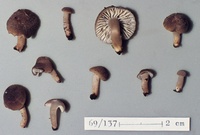
Caption: ZT69-137
Owner: E. Horak: © Creative Commons Attribution-Noncommercial 3.0 New Zealand | 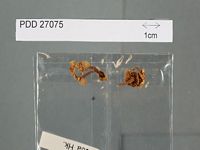
Caption: Dried type specimen
Owner: Herb PDD |
Article: Horak, E. (1990). Monograph of the New Zealand Hygrophoraceae (Agaricales). New Zealand Journal of Botany 28(3): 255-306 (http://www.rsnz.org/publish/abstracts.php).
Description: Pileus -50 mm, hemispherical, convex to broadly umbonate, centre flat to subdepressed
in aged basidiomes; pale brown, grey-brown to soot brown, paler towards margin:
conspicuously velutinous, felty, on disc often breaking up into small concentrically
arranged squamules, dry, obscurely Striate when moist, opaque, margin splitting
with age. - lamellae 14-22 (1 -5) broadly adnate to decurrent, arcuate, emarginate-ventricose
in aged basidiomes, up to 11 mm wide, occasionally anastomosing at base; whitish
to pale brown, often with sooty tints, edges concolorous, entire, rarely forked
towards margin of pileus. - Stipe 8-45 x 1.5-8 mm, equal or tapering towards
base, often enlarged into pileus; concolorous with pileus or paler, occasionally
with orange or pale red-brown tinge; dry, glabrous to subpruinose at apex, otherwise
minutely fibrillose, stiff, often twisted, solid becoming fistulose, single.
- Context whitish to pale brown or grey-brown, brown in base of stipe (occasionally
with reddish tinge). - Odour and taste absent or slightly acidulous, fragrant,
mild. - Chemical reactions on pileus: KOH, HCl negative.
Spores (3-) 3.5-4.5 (-5) um, subglobose with distinct apiculus, inamyloid but
sometimes faintly dextrinoid or amyloid. - Basidia 22-36 x 4-6 um, 4-spored.
- Cheilo- and pleurocystidia absent - Caulocystidia 10-40 x 3-10 um, cylindrical
to clavate, membrane hyaline, encrusted with pigment. - Pileipellis a palisade
or trichoderm of erect, bundled, short-cylindrical hyphae (4-12 um diam.), terminal
cells fusoid, clavate or conical, membrane not gelatinised, encrusted with brown
(KOH) pigment, often also dissolved in cell sap, oleiferous hyphae absent; clamp
connections absent (Pl. 1, Fig. 3).
Habitat: ECOLOGY: Common; saprobic on soil among moss, Sphagnum or litter (sometimes
also on rotten fallen logs) in beech forests (Nothofagus solandri var. cliffortioides.
N.fusca), mixed broadleaved-conifer forests (Leptospermum scoparium,
Metrosideros sp., Weinmannia racemosa, Dacrydium cupressinum), shrubs
(Senecio sp.) or under tree fems (Dicksonia). March.
Distribution: DISTRIBUTION: NZ (N, WL, SL, STI).
Notes: The taxonomic position of this polymorphic yet readily recognised agaric in the genus Aeruginospora (only known from its type locality in Java, Indonesia) is questionable. Morphologically the New Zealand taxon resembles several European species lumped into Hygrophorus (Moser, 1983) or Hygrotrama (Singer 1962; Arnolds 1985).
Article: Horak, E. (1973). Fungi Agaricini Novazelandiae I-V. Beihefte zur Nova Hedwigia 43: 200 p.
Description: Pileus 5-20 mm diam., hemispherical when young becoming convex to campanulate, aged specimen plane, grey-beige, brownish to dark beige densely covered with small concolorous scales or squamules, felty, degraded carpophores sometimes concentrically cracking, dry, estriate. Lamellae emarginate-adnate to subdecurrent, anastomosing, whitish-grey turning beige, subdistant, gill edge concolorous, even. Stipe 8-20 x 1.5-3 mm, attenuated towards the base, rarely equal, concolorous with pileus, apex pruinose, elsewhere glabrous, dry, solid, single. Context whitish-beige, not waxy. Taste and odor slightly acidulous or not distinctive. Chemical reactions on Pileus: KOH, HCl - negative.
Spores 3.5-4.5(5) µm, subglobose, smooth, dextrinoid to faintly amyloid. Basidia 25-36 x 5 µm, 4 (rarely also) 2-spored. Cystidia lacking. Cuticle a palisade consisting of erect, short-cylindric, not gelatinized hyphae (6-12 µm diam.), terminal cells apically rounded or conic, vacuolar and plasmatic pigment present. Clamp connections absent on cuticular hyphae.
Habitat: On soil under Nothofagus, Metrosideros, Weinmannia, Senecio, etc. New Zealand.
Notes: This is a striking species by virtue of the brownish, unchanging, squamulose pileus, subglobose spores and absence of clamp connections.
|